Pumping Station Desing - Second Edition by Robert L. Sanks, George Tchobahoglous, Garr M. Jones
Подождите немного. Документ загружается.

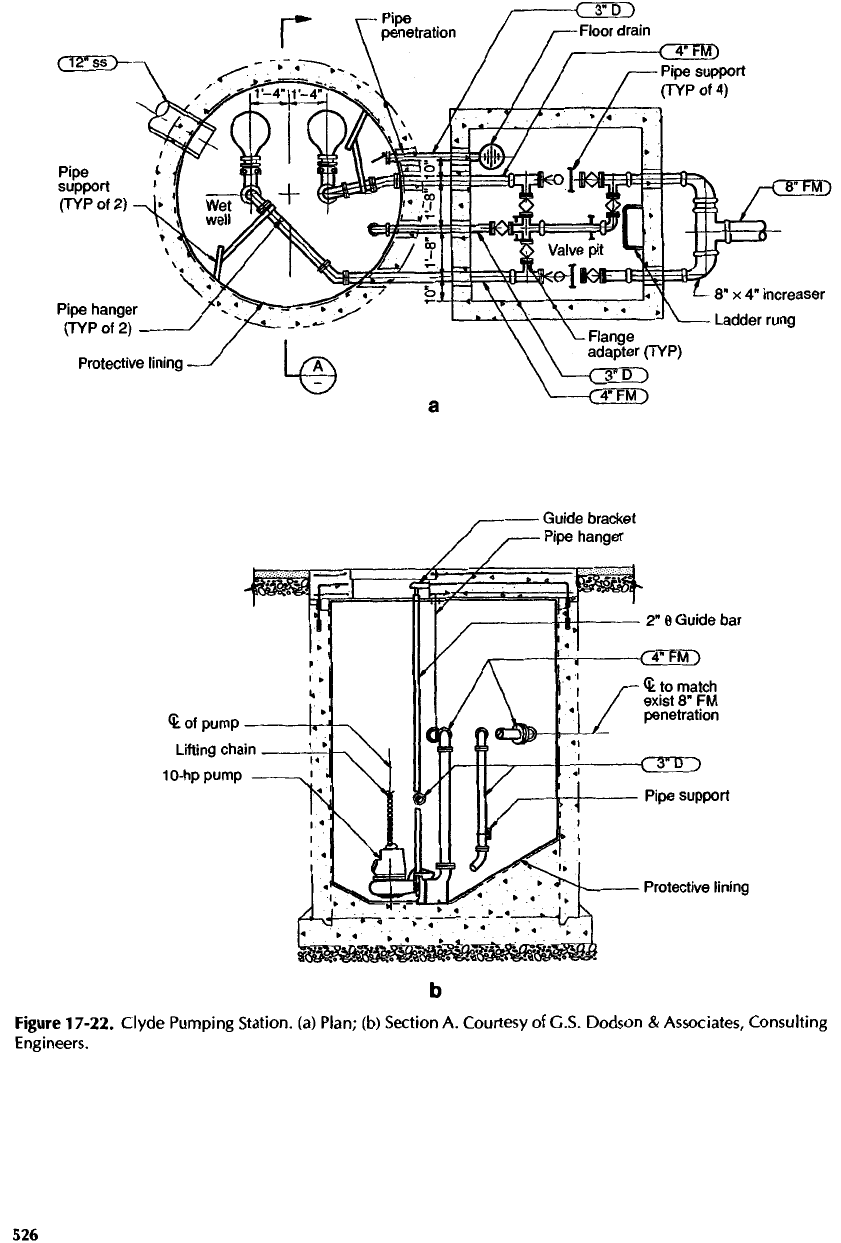
Figure
17-22.
Clyde Pumping
Station,
(a)
Plan;
(b)
Section
A.
Courtesy
of
C.S. Dodson
&
Associates,
Consulting
Engineers.
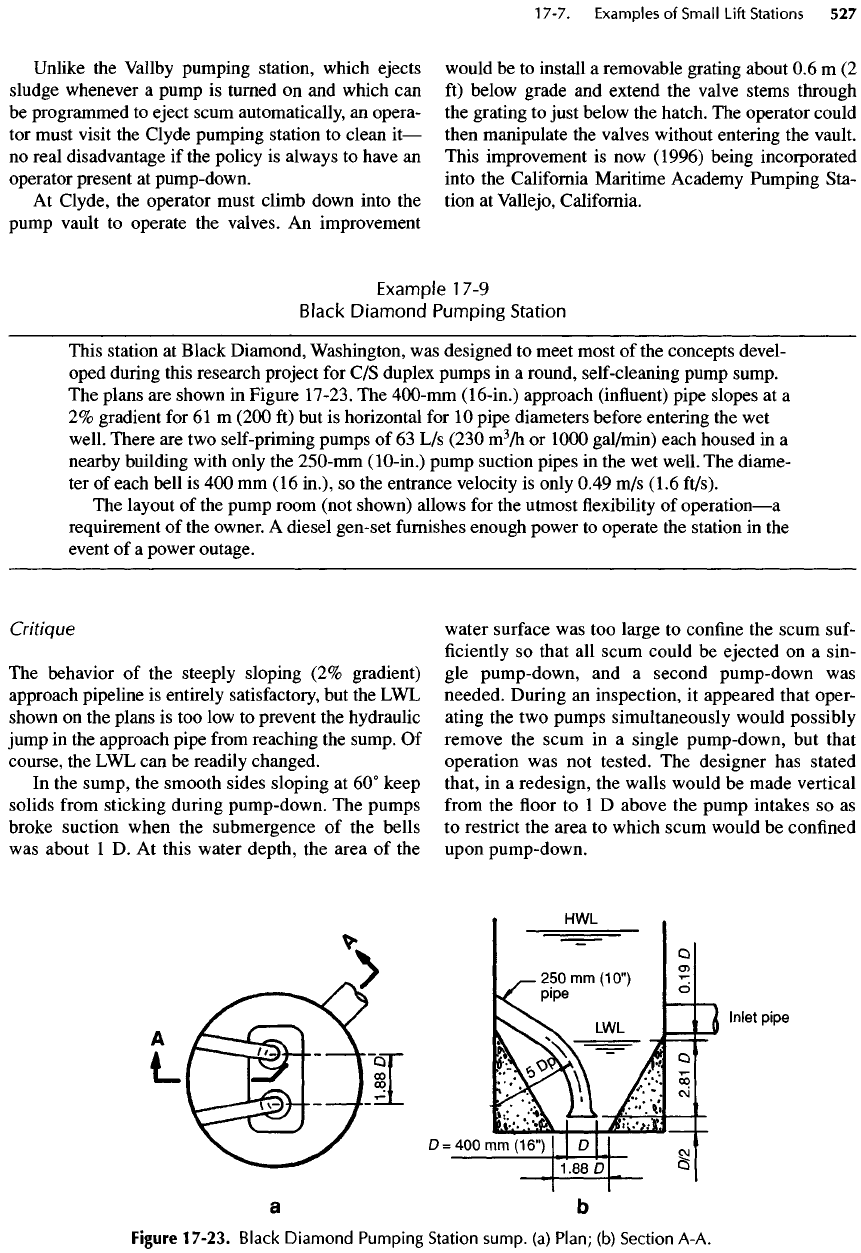
Unlike
the
Vallby
pumping station, which ejects
sludge whenever
a
pump
is
turned
on and
which
can
be
programmed
to
eject scum automatically,
an
opera-
tor
must visit
the
Clyde pumping station
to
clean
it
—
no
real disadvantage
if the
policy
is
always
to
have
an
operator present
at
pump-down.
At
Clyde,
the
operator must climb down into
the
pump
vault
to
operate
the
valves.
An
improvement
would
be to
install
a
removable grating about
0.6
m
(2
ft)
below grade
and
extend
the
valve stems through
the
grating
to
just below
the
hatch.
The
operator could
then
manipulate
the
valves without entering
the
vault.
This improvement
is now
(1996) being incorporated
into
the
California Maritime Academy Pumping Sta-
tion
at
Vallejo, California.
Example
17-9
Black
Diamond
Pumping
Station
This station
at
Black Diamond, Washington,
was
designed
to
meet most
of the
concepts devel-
oped during this research project
for C/S
duplex pumps
in a
round, self-cleaning pump sump.
The
plans
are
shown
in
Figure 17-23.
The
400-mm
(16-in.)
approach
(influent)
pipe slopes
at a
2%
gradient
for 61 m
(200
ft) but is
horizontal
for 10
pipe diameters before entering
the wet
well. There
are two
self-priming
pumps
of 63 L/s
(230
m
3
/h
or
1000
gal/min)
each housed
in a
nearby
building with only
the
250-mm
(10-in.)
pump suction pipes
in the wet
well.
The
diame-
ter
of
each bell
is 400 mm (16
in.),
so the
entrance velocity
is
only 0.49
m/s
(1.6
ft/s).
The
layout
of the
pump room (not shown) allows
for the
utmost
flexibility of
operation—a
requirement
of the
owner.
A
diesel
gen-set
furnishes
enough power
to
operate
the
station
in the
event
of a
power outage.
Critique
The
behavior
of the
steeply sloping
(2%
gradient)
approach pipeline
is
entirely satisfactory,
but the LWL
shown
on the
plans
is too low to
prevent
the
hydraulic
jump
in the
approach pipe
from
reaching
the
sump.
Of
course,
the LWL can be
readily changed.
In
the
sump,
the
smooth sides sloping
at 60°
keep
solids
from
sticking during pump-down.
The
pumps
broke suction when
the
submergence
of the
bells
was
about
1 D. At
this water depth,
the
area
of the
water surface
was too
large
to
confine
the
scum suf-
ficiently
so
that
all
scum could
be
ejected
on a
sin-
gle
pump-down,
and a
second pump-down
was
needed. During
an
inspection,
it
appeared that oper-
ating
the two
pumps simultaneously would possibly
remove
the
scum
in a
single pump-down,
but
that
operation
was not
tested.
The
designer
has
stated
that,
in a
redesign,
the
walls would
be
made vertical
from
the floor to 1 D
above
the
pump intakes
so as
to
restrict
the
area
to
which scum would
be
confined
upon pump-down.
Figure
17-23.
Black
Diamond
Pumping
Station
sump,
(a)
Plan;
(b)
Section
A-A.
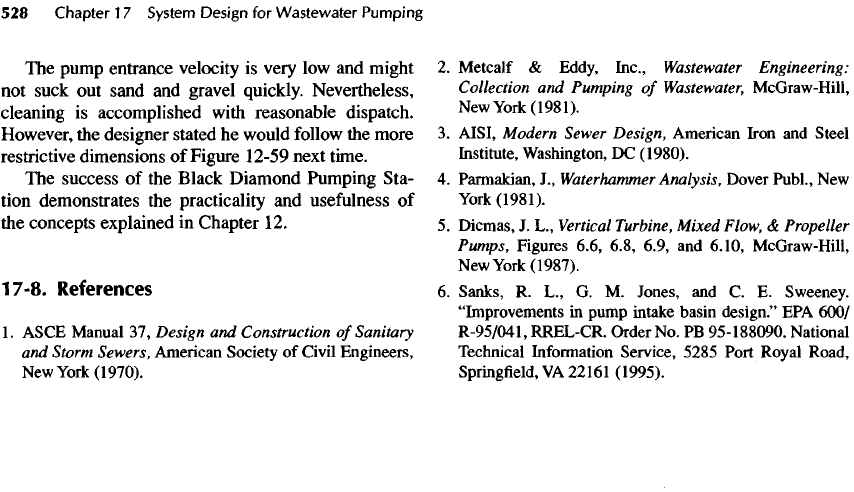
The
pump entrance velocity
is
very
low and
might
not
suck
out
sand
and
gravel quickly. Nevertheless,
cleaning
is
accomplished
with
reasonable dispatch.
However,
the
designer stated
he
would follow
the
more
restrictive
dimensions
of
Figure 12-59 next time.
The
success
of the
Black Diamond Pumping Sta-
tion demonstrates
the
practicality
and
usefulness
of
the
concepts explained
in
Chapter
12.
17-8.
References
1.
ASCE Manual
37,
Design
and
Construction
of
Sanitary
and
Storm Sewers, American Society
of
Civil Engineers,
New
York
(1970).
2.
Metcalf
&
Eddy,
Inc.,
Wastewater
Engineering:
Collection
and
Pumping
of
Wastewater,
McGraw-Hill,
New
York
(1981).
3.
AISI,
Modern
Sewer Design, American Iron
and
Steel
Institute,
Washington,
DC
(1980).
4.
Parmakian,
J.,
Waterhammer
Analysis, Dover
Publ.,
New
York
(1981).
5.
Dicmas,
J.
L.,
Vertical
Turbine,
Mixed
Flow,
&
Propeller
Pumps,
Figures
6.6, 6.8, 6.9,
and
6.10,
McGraw-Hill,
New
York
(1987).
6.
Sanks,
R.
L.,
G. M.
Jones,
and C. E.
Sweeney.
"Improvements
in
pump intake basin design."
EPA
600/
R-95/041,
RREL-CR. Order
No. PB
95-188090.
National
Technical Information Service, 5285 Port Royal Road,
Springfield,
VA
22161
(1995).
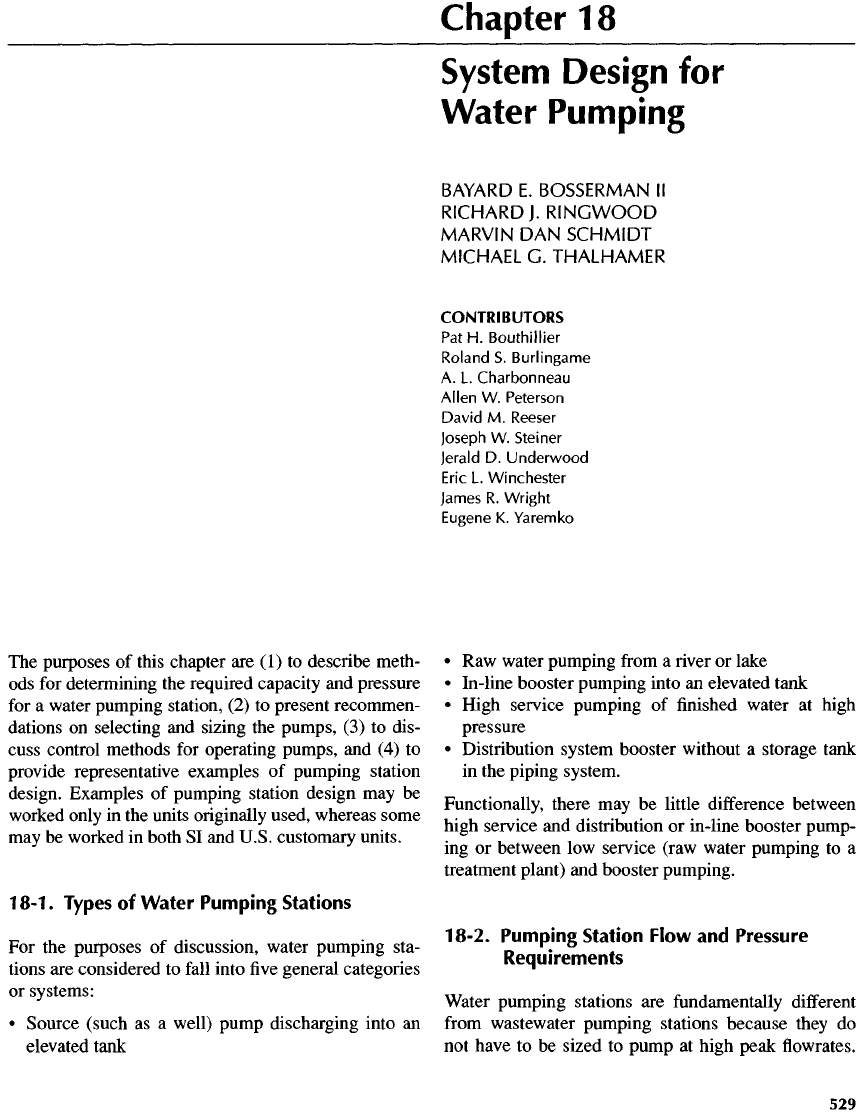
The
purposes
of
this chapter
are
(1)
to
describe meth-
ods for
determining
the
required capacity
and
pressure
for
a
water pumping station,
(2) to
present recommen-
dations
on
selecting
and
sizing
the
pumps,
(3) to
dis-
cuss
control methods
for
operating pumps,
and (4) to
provide representative examples
of
pumping station
design. Examples
of
pumping station design
may be
worked
only
in the
units originally used, whereas some
may
be
worked
in
both
SI and
U.S. customary units.
1
8-1
.
Types
of
Water
Pumping
Stations
For the
purposes
of
discussion, water pumping sta-
tions
are
considered
to
fall
into
five
general categories
or
systems:
•
Source (such
as a
well) pump discharging into
an
elevated tank
Chapter
1
8
System
Design
for
Water
Pumping
BAYARD
E.
BOSSERMAN
Il
RICHARD
J.
RINGWOOD
MARVIN
DAN
SCHMIDT
MICHAEL
G.
THALHAMER
CONTRIBUTORS
Pat H.
Bouthillier
Roland
S.
Burlingame
A. L.
Charbonneau
Allen
W.
Peterson
David
M.
Reeser
Joseph
W.
Steiner
Jerald
D.
Underwood
Eric
L.
Winchester
James
R.
Wright
Eugene
K.
Yaremko
• Raw
water pumping
from
a
river
or
lake
•
In-line booster pumping into
an
elevated tank
•
High service pumping
of finished
water
at
high
pressure
•
Distribution system booster without
a
storage tank
in
the
piping system.
Functionally, there
may be
little
difference
between
high
service
and
distribution
or
in-line booster pump-
ing
or
between
low
service
(raw water pumping
to a
treatment plant)
and
booster pumping.
18-2.
Pumping
Station
Flow
and
Pressure
Requirements
Water
pumping stations
are
fundamentally
different
from
wastewater pumping stations because they
do
not
have
to be
sized
to
pump
at
high peak
flowrates.

A
wastewater pumping station must
be
able
to
pump
whatever
sewage
flow
enters
it, but a
water pumping
station
can be
designed
to
take advantage
of
water
storage
reservoirs
in the
system.
Flow
Requirements
Water
pumping stations
are
usually designed
to
supply
water
to an
area
in
which
the
required demand
is
reason-
ably
well defined
or can be
projected
to a
reasonable
degree.
In a
water distribution system,
the
demand
is a
combination
of
customer needs
and fire flow
require-
ments. Average annual
per
capita water consumption,
peak hour,
and
maximum daily demands
vary
widely
depending
on
factors
such
as
climate, income levels,
population,
and the
proportions
of
residential, commer-
cial,
and
industrial users. Typical water consumption
values
are 560 to 760
L/cap
• d or 150 to 200
gal/cap
• d.
More
detailed data
on per
capita water demand
is
readily
available
[1-5].
Most water supply utilities
and
cities
also have extensive records
on
water consumption.
Fire
flow
requirements
are
usually dictated
by the
fire
code
adopted
by the
local jurisdiction. Formulas
based
on
population
or on the
individual buildings
[where area, height, type
of
construction, occupancy,
installation
of
automatic sprinklers,
and
proximity
(and
thus exposure)
to
other structures]
may be
useful.
For
example,
the fire flow
requirement
can be
esti-
mated
using
an
early National Board
of
Fire
Under-
writers formula.
In SI
units,
the
formula
is
Q
=
2327^(1-0.01^)
(18-la)
in
which
Q is the fire
demand
flow in
cubic meters
per
hour
and P is the
population
in
thousands.
In
U.S. cus-
tomary
units,
the
formula
is
Q
=
1020
JP(\-
0.01
JP)
(18-lb)
where
Q is fire
demand
flow in
gallons
per
minute
and
P,
again,
is the
population
in
thousands.
Be
wary
of
computing
fire flows
based
on
formulas
that include
only
the
population
factor
because they
can
give
unreal-
istically
low flow
values
in
comparison
to a fire flow
demand
that might actually occur.
For
example,
in a
town
of
1000 people,
P
would
be 1 and Q
would
be 230
m
3
/h
(1000
gal/min),
which
may be
inadequate.
The
presence
of a
lumber yard,
for
example, would require
a
high water
flow
allocated
for fire.
Furthermore, design
flows
for
pumping stations
and
water mains depend
on
the
reservoir storage capacity available. Generally,
the
design
flow
should
be the
larger
of (1)
peak hourly
demand
or (2)
maximum daily demand plus
fire flow.
For
commercial areas,
the flow
demand
is
usually
estimated
as flowrate per
area. Demands
of
18.7
to 47
m
3
/ha
• d
(2000
to
5000
gal/acre
• d) are not
unusual
in
mixed
commercial
and
residential areas
[2,3,4,5].
Zoning classifications greatly
affect
these unit
flows.
In
one
large water agency
on the
East Coast
of the
United States, water consumption varies
from
18.7
to
700
m
3
/ha
• d
(2000
to
75,000
gal/acre
• d)
depending
on
the
zoning classification.
Pressure
Requirements
Service connection pressures during normal system
operations should
lie
between
the
following limits:
•
Minimum pressure
=
210-280
kPa
(30-40
lb/in.
2
)
•
Maximum pressure
=
410-550
kPa
(60-80
lb/in.
2
)
Some
cities
and
agencies
further
define
acceptable
minimum
pressures
as, for
example,
• 276 kPa (40
lb/in.
2
)
for
maximum daily
flow
• 207 kPa (30
lb/in.
2
)
for
peak hourly
flow
• 138 kPa (20
lb/in.
2
)
for
maximum daily
flow
plus
fire flow.
A
frequent
practice
in
water districts
is to
have zones
with
a 45- to
60-m
(150-
to
200-ft)
difference
in
eleva-
tion
from
top to
bottom. This corresponds roughly
to
the
maximum
410 to 550 kPa (60 to 80
lb/in.
2
)
pres-
sure
range above.
A
major
reason
for the
maximum
pressure
of 550 kPa (80
lb/in.
2
)
is
that household
plumbing
fixtures
—
especially
water
heaters
—
cannot
withstand
greater pressures.
In
sparsely populated areas,
it is
possible
to
estab-
lish zones with
a
90-m
(300-ft)
difference
in
elevation
and
to
serve
the
lower areas through pressure-reducing
valves.
It is
also
possible
to use
booster pumping
and
storage
in
alternating zones
(e.g.,
pump
from
zone
1 to
3 to 5) and to
service intermediate zones
(e.g.,
zones
2
and
4)
through pressure-reducing valves until addi-
tional
pumping
and
storage facilities
can be
justified.
Example
18-1
Flow
Requirements
in a
Small
Town
Problem:
A
town
has a
population
of
10,000.
Find
the
requirements
of the
water supply system
if
(1) an
adequate reservoir
is to be
built,
(2) an
existing
but
somewhat inadequate reservoir
exists,
and (3)
there
is no
reservoir.
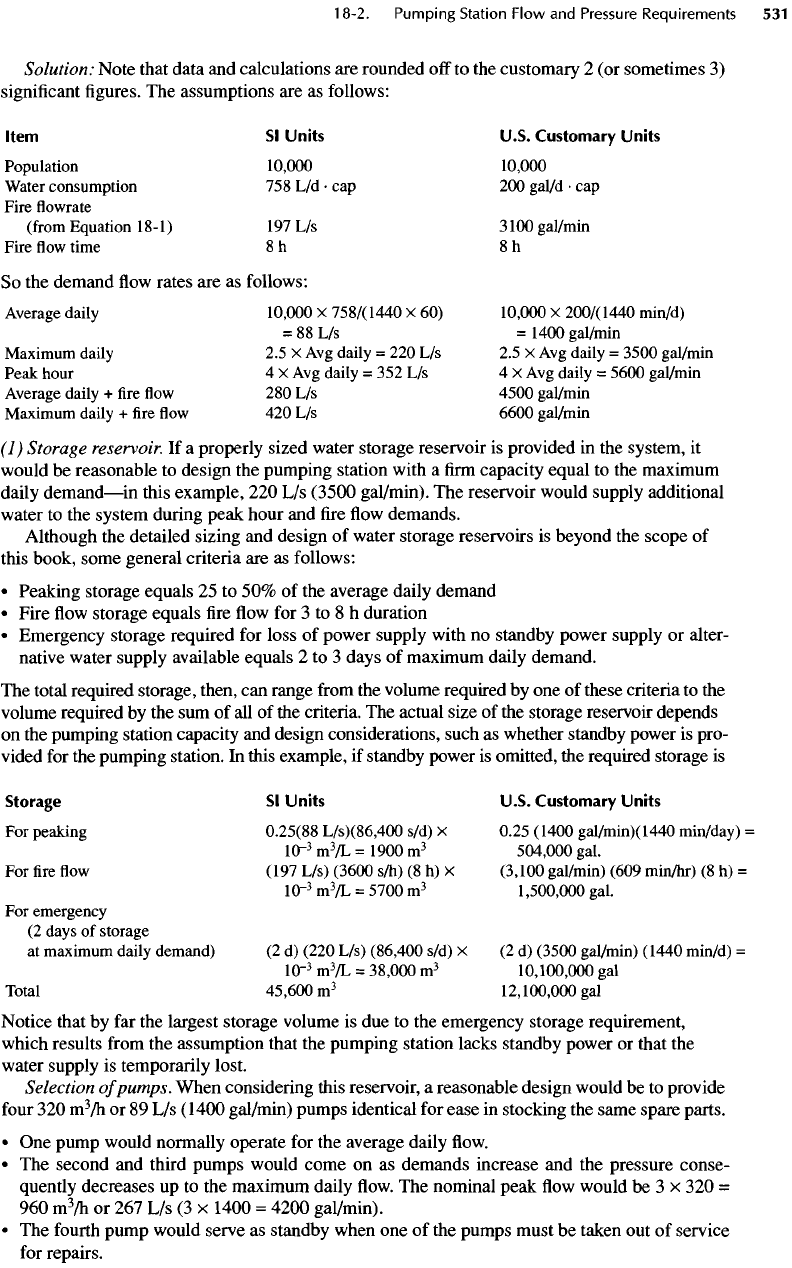
Solution:
Note that data
and
calculations
are
rounded
off
to the
customary
2 (or
sometimes
3)
significant
figures.
The
assumptions
are as
follows:
Item
Sl
Units
U.S. Customary
Units
Population
10,000
10,000
Water
consumption
758 L/d • cap 200
gal/d
• cap
Fire
flowrate
(from
Equation 18-1)
197 L/s
3100
gal/min
Fire
flow
time
8 h 8 h
So the
demand
flow
rates
are as
follows:
Average
daily
10,000
X
758/(1440
X 60)
10,000
X
200/(1440
min/d)
=
88 L/s =
1400 gal/min
Maximum
daily
2.5 X Avg
daily
= 220 L/s 2.5 X Avg
daily
=
3500
gal/min
Peak hour
4 X Avg
daily
= 352 L/s 4 X Avg
daily
=
5600
gal/min
Average
daily
+ fire flow 280 L/s
4500
gal/min
Maximum
daily
+ fire flow 420 L/s
6600
gal/min
(1)
Storage
reservoir.
If a
properly sized water storage reservoir
is
provided
in the
system,
it
would
be
reasonable
to
design
the
pumping station with
a firm
capacity equal
to the
maximum
daily
demand—in
this example,
220 L/s
(3500
gal/min).
The
reservoir would supply additional
water
to the
system during peak hour
and fire flow
demands.
Although
the
detailed sizing
and
design
of
water storage reservoirs
is
beyond
the
scope
of
this book, some general
criteria
are as
follows:
•
Peaking storage equals
25 to 50% of the
average daily demand
•
Fire
flow
storage equals
fire flow for 3 to 8 h
duration
•
Emergency storage required
for
loss
of
power supply with
no
standby power supply
or
alter-
native water supply available equals
2 to 3
days
of
maximum daily demand.
The
total required storage, then,
can
range
from
the
volume required
by one of
these criteria
to the
volume
required
by the sum of all of the
criteria.
The
actual size
of the
storage reservoir depends
on
the
pumping station capacity
and
design considerations, such
as
whether standby power
is
pro-
vided
for the
pumping station.
In
this example,
if
standby power
is
omitted,
the
required storage
is
Storage
Sl
Units U.S. Customary
Units
For
peaking
0.25(88
L/s)(86,400
s/d)
X
0.25 (1400
gal/min)(1440
min/day)
=
IQ-
3
m
3
/L
=
1900
m
3
504,000
gal.
For fire flow
(197 L/s)
(3600
s/h)
(8 h) X
(3,100
gal/min) (609
min/hr)
(8 h) =
10-
3
m
3
/L
=
5700
m
3
1,500,000
gal.
For
emergency
(2
days
of
storage
at
maximum daily demand)
(2 d)
(220 L/s)
(86,400
s/d)
X (2 d)
(3500
gal/min) (1440 min/d)
=
10-
3
m
3
/L
=
38,000
m
3
10,100,000
gal
Total
45,600
m
3
12,100,000
gal
Notice that
by far the
largest storage volume
is due to the
emergency storage requirement,
which
results
from
the
assumption that
the
pumping station lacks standby power
or
that
the
water
supply
is
temporarily lost.
Selection
of
pumps. When considering this reservoir,
a
reasonable design would
be to
provide
four
320
m
3
/h
or 89 L/s
(1400 gal/min) pumps identical
for
ease
in
stocking
the
same spare parts.
• One
pump would normally operate
for the
average daily
flow.
• The
second
and
third pumps would come
on as
demands increase
and the
pressure conse-
quently
decreases
up to the
maximum daily
flow. The
nominal peak
flow
would
be 3 x 320 =
960
m
3
/h
or 267 L/s (3 x
1400
=
4200
gal/min).
• The
fourth
pump would serve
as
standby when
one of the
pumps must
be
taken
out of
service
for
repairs.
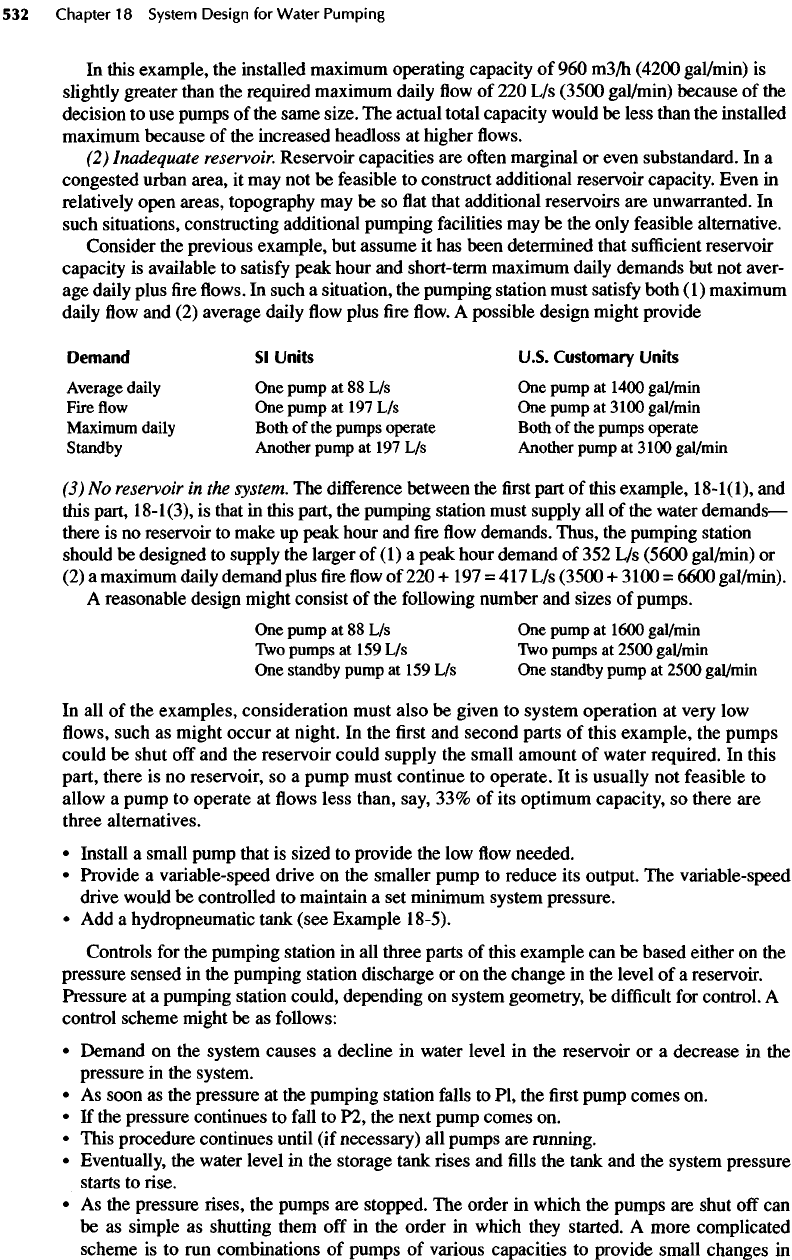
In
this example,
the
installed maximum operating capacity
of 960
m3/h
(4200
gal/min)
is
slightly greater than
the
required maximum daily
flow of 220 L/s
(3500
gal/min)
because
of the
decision
to use
pumps
of the
same
size.
The
actual total capacity would
be
less than
the
installed
maximum
because
of the
increased headloss
at
higher
flows.
(2)
Inadequate
reservoir.
Reservoir capacities
are
often
marginal
or
even substandard.
In a
congested urban area,
it may not be
feasible
to
construct additional reservoir capacity. Even
in
relatively open areas, topography
may be so flat
that additional reservoirs
are
unwarranted.
In
such
situations, constructing additional pumping facilities
may be the
only feasible alternative.
Consider
the
previous example,
but
assume
it has
been determined that
sufficient
reservoir
capacity
is
available
to
satisfy
peak hour
and
short-term maximum daily demands
but not
aver-
age
daily plus
fire flows. In
such
a
situation,
the
pumping station must
satisfy
both
(1)
maximum
daily
flow and (2)
average daily
flow
plus
fire flow. A
possible
design might provide
Demand
Sl
Units U.S. Customary Units
Average
daily
One
pump
at 88 L/s One
pump
at
1400 gal/min
Fire
flow One
pump
at
197
L/s One
pump
at
3100
gal/min
Maximum
daily Both
of the
pumps operate Both
of the
pumps operate
Standby
Another pump
at
197
L/s
Another pump
at
3100
gal/min
(3)
No
reservoir
in the
system.
The
difference
between
the first
part
of
this example,
18-1(1),
and
this part,
18-1(3),
is
that
in
this part,
the
pumping station must supply
all of the
water
demands—
there
is no
reservoir
to
make
up
peak hour
and fire flow
demands. Thus,
the
pumping station
should
be
designed
to
supply
the
larger
of (1) a
peak hour demand
of 352 L/s
(5600
gal/min)
or
(2)
a
maximum daily demand plus
fire flow of 220 + 197 = 417 L/s
(3500
+
3100
=
6600
gal/min).
A
reasonable design might consist
of the
following number
and
sizes
of
pumps.
One
pump
at 88 L/s One
pump
at
1600
gal/min
Two
pumps
at 159 L/s Two
pumps
at
2500
gal/min
One
standby pump
at 159 L/s One
standby pump
at
2500
gal/min
In
all of the
examples, consideration must also
be
given
to
system operation
at
very
low
flows,
such
as
might occur
at
night.
In the first and
second parts
of
this example,
the
pumps
could
be
shut
off and the
reservoir could supply
the
small amount
of
water required.
In
this
part, there
is no
reservoir,
so a
pump must continue
to
operate.
It is
usually
not
feasible
to
allow
a
pump
to
operate
at flows
less than,
say,
33% of its
optimum capacity,
so
there
are
three alternatives.
•
Install
a
small pump that
is
sized
to
provide
the low flow
needed.
•
Provide
a
variable-speed drive
on the
smaller pump
to
reduce
its
output.
The
variable-speed
drive would
be
controlled
to
maintain
a set
minimum system pressure.
• Add a
hydropneumatic tank
(see
Example
18-5).
Controls
for the
pumping station
in all
three parts
of
this example
can be
based either
on the
pressure sensed
in the
pumping station discharge
or on the
change
in the
level
of a
reservoir.
Pressure
at a
pumping station could, depending
on
system geometry,
be
difficult
for
control.
A
control scheme might
be as
follows:
•
Demand
on the
system causes
a
decline
in
water level
in the
reservoir
or a
decrease
in the
pressure
in the
system.
• As
soon
as the
pressure
at the
pumping station
falls
to Pl, the first
pump comes
on.
• If the
pressure continues
to
fall
to
P2,
the
next pump
comes
on.
•
This procedure continues until
(if
necessary)
all
pumps
are
running.
•
Eventually,
the
water level
in the
storage tank
rises
and fills the
tank
and the
system pressure
starts
to rise.
• As the
pressure
rises, the
pumps
are
stopped.
The
order
in
which
the
pumps
are
shut
off
can
be as
simple
as
shutting them
off in the
order
in
which they started.
A
more complicated
scheme
is to run
combinations
of
pumps
of
various capacities
to
provide small changes
in
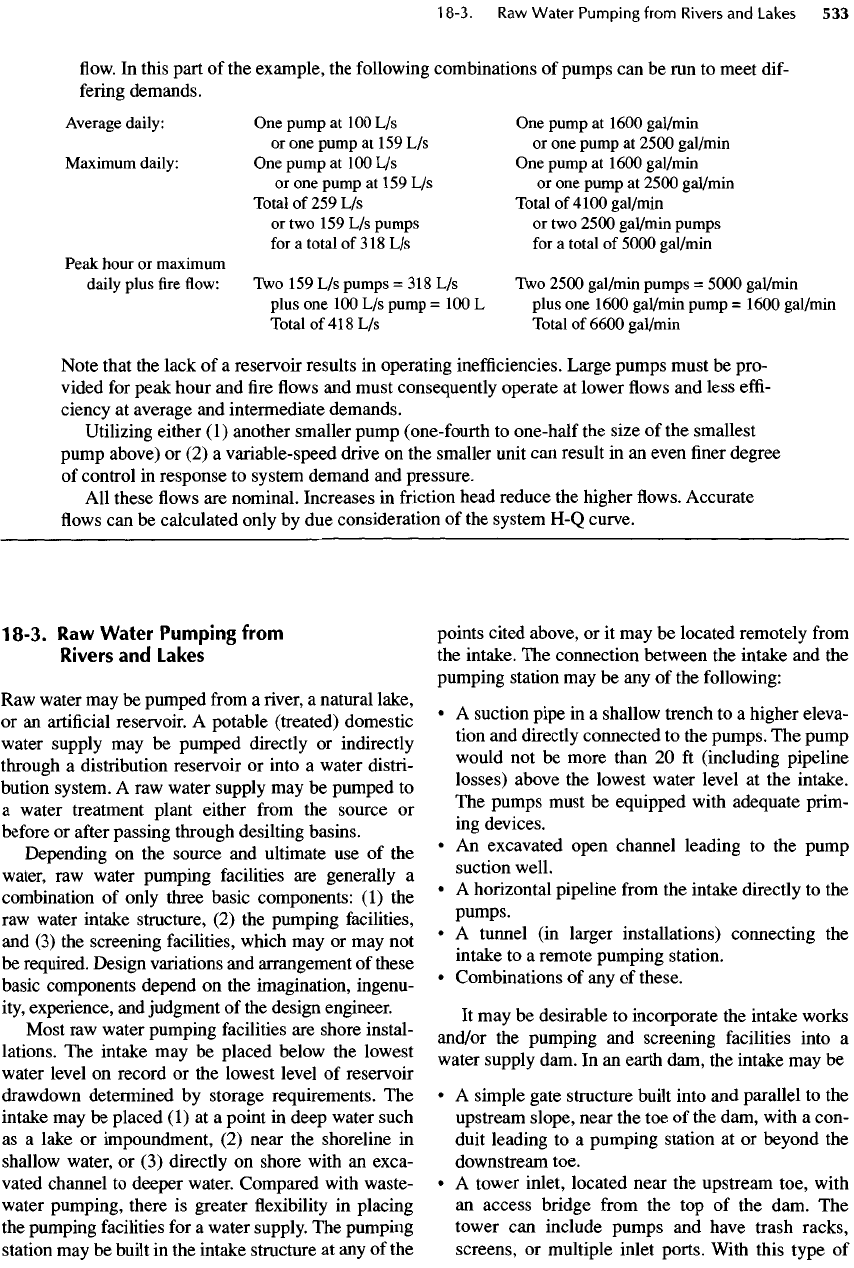
1
8-3.
Raw
Water
Pumping
from
Rivers
and
Lakes
Raw
water
may be
pumped
from
a river, a
natural lake,
or an
artificial
reservoir.
A
potable (treated) domestic
water
supply
may be
pumped directly
or
indirectly
through
a
distribution reservoir
or
into
a
water
distri-
bution
system.
A raw
water supply
may be
pumped
to
a
water treatment plant either
from
the
source
or
before
or
after
passing through desilting basins.
Depending
on the
source
and
ultimate
use of the
water,
raw
water pumping facilities
are
generally
a
combination
of
only three basic components:
(1)
the
raw
water intake structure,
(2) the
pumping facilities,
and
(3) the
screening facilities, which
may or may not
be
required. Design variations
and
arrangement
of
these
basic components depend
on the
imagination, ingenu-
ity,
experience,
and
judgment
of the
design
engineer.
Most
raw
water pumping facilities
are
shore instal-
lations.
The
intake
may be
placed below
the
lowest
water
level
on
record
or the
lowest level
of
reservoir
drawdown
determined
by
storage requirements.
The
intake
may be
placed
(1)
at a
point
in
deep water such
as
a
lake
or
impoundment,
(2)
near
the
shoreline
in
shallow
water,
or (3)
directly
on
shore with
an
exca-
vated
channel
to
deeper water. Compared with waste-
water
pumping, there
is
greater
flexibility in
placing
the
pumping facilities
for a
water supply.
The
pumping
station
may be
built
in the
intake structure
at any of the
points cited above,
or it may be
located remotely
from
the
intake.
The
connection between
the
intake
and the
pumping
station
may be any of the
following:
• A
suction pipe
in a
shallow trench
to a
higher eleva-
tion
and
directly connected
to the
pumps.
The
pump
would
not be
more than
20 ft
(including pipeline
losses) above
the
lowest water level
at the
intake.
The
pumps must
be
equipped with adequate prim-
ing
devices.
• An
excavated open channel leading
to the
pump
suction
well.
• A
horizontal pipeline
from
the
intake directly
to the
pumps.
• A
tunnel
(in
larger installations) connecting
the
intake
to a
remote pumping station.
•
Combinations
of any of
these.
It
may be
desirable
to
incorporate
the
intake works
and/or
the
pumping
and
screening facilities into
a
water supply dam.
In an
earth dam,
the
intake
may be
• A
simple gate structure built into
and
parallel
to the
upstream
slope, near
the toe of the
dam, with
a
con-
duit
leading
to a
pumping station
at or
beyond
the
downstream
toe.
• A
tower
inlet,
located near
the
upstream toe, with
an
access bridge
from
the top of the
dam.
The
tower
can
include pumps
and
have trash racks,
screens,
or
multiple inlet
ports.
With this type
of
Note that
the
lack
of a
reservoir results
in
operating
inefficiencies.
Large pumps must
be
pro-
vided
for
peak hour
and fire flows and
must consequently operate
at
lower
flows and
less
effi-
ciency
at
average
and
intermediate demands.
Utilizing
either
(1)
another smaller pump (one-fourth
to
one-half
the
size
of the
smallest
pump
above)
or (2) a
variable-speed
drive
on the
smaller
unit
can
result
in an
even
finer
degree
of
control
in
response
to
system demand
and
pressure.
All
these
flows are
nominal.
Increases
in
friction
head reduce
the
higher
flows.
Accurate
flows
can
be
calculated only
by due
consideration
of the
system
H-Q
curve.
Average
daily:
Maximum
daily:
Peak hour
or
maximum
daily
plus
fire flow:
One
pump
at
100
L/s
or
one
pump
at 159 L/s
One
pump
at
100
L/s
or
one
pump
at 159 L/s
Total
of 259 L/s
or
two 159 L/s
pumps
for
a
total
of
3
18
L/s
Two
159 L/s
pumps
=
318
L/s
plus
one 100 L/s
pump
= 100 L
Total
of 418 L/s
One
pump
at
1600
gal/min
or
one
pump
at
2500
gal/min
One
pump
at
1600
gal/min
or
one
pump
at
2500
gal/min
Total
of
4100 gal/min
or
two
2500
gal/min pumps
for
a
total
of
5000
gal/min
Two
2500
gal/min pumps
=
5000
gal/min
plus
one
1600
gal/min pump
=
1600
gal/min
Total
of
6600
gal/min
flow.
In
this part
of the
example,
the
following
combinations
of
pumps
can be run to
meet dif-
fering
demands.
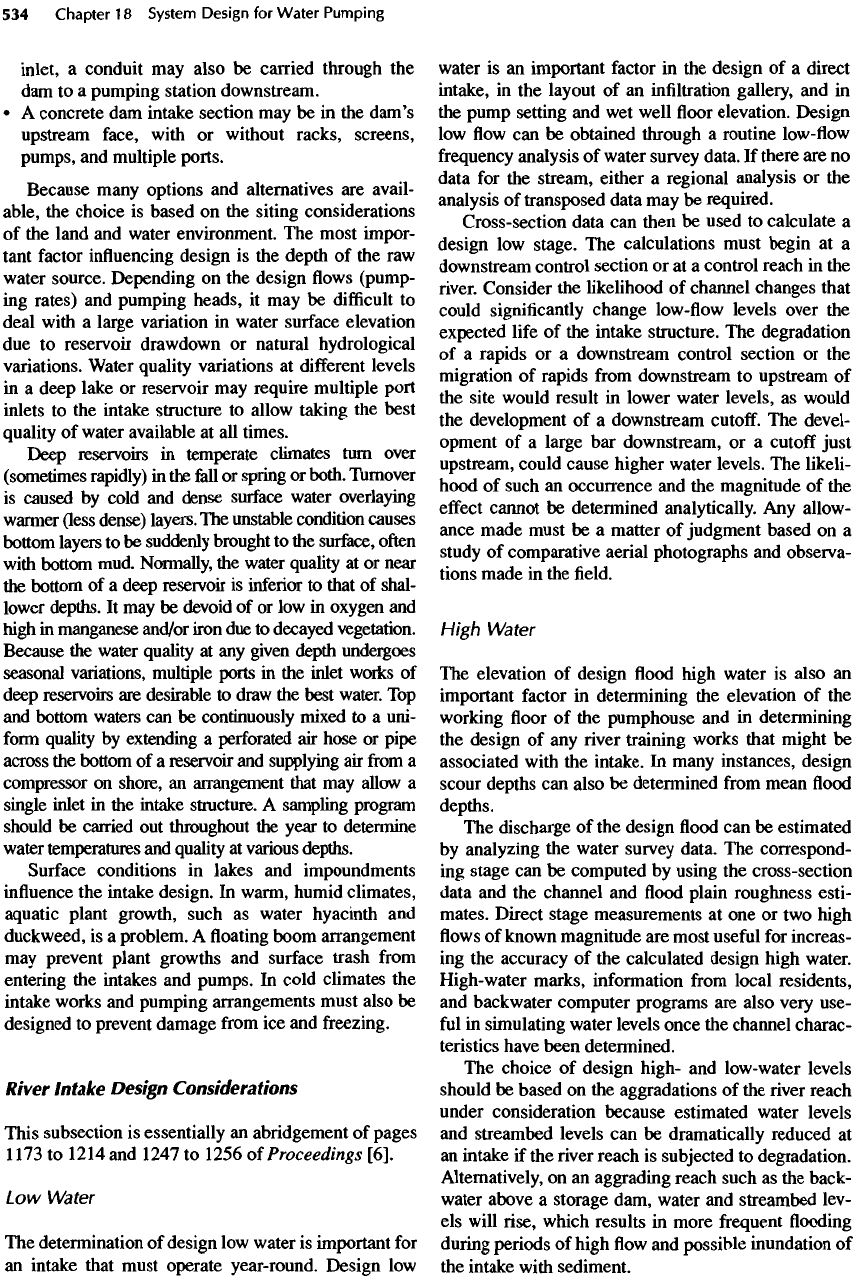
inlet,
a
conduit
may
also
be
carried
through
the
dam
to a
pumping station downstream.
• A
concrete
dam
intake section
may be in the
dam's
upstream face, with
or
without racks, screens,
pumps,
and
multiple ports.
Because many options
and
alternatives
are
avail-
able,
the
choice
is
based
on the
siting considerations
of
the
land
and
water environment.
The
most impor-
tant
factor
influencing
design
is the
depth
of the raw
water source. Depending
on the
design
flows
(pump-
ing
rates)
and
pumping heads,
it may be
difficult
to
deal with
a
large variation
in
water surface elevation
due
to
reservoir drawdown
or
natural hydrological
variations. Water quality variations
at
different
levels
in
a
deep lake
or
reservoir
may
require multiple port
inlets
to the
intake structure
to
allow taking
the
best
quality
of
water available
at all
times.
Deep reservoirs
in
temperate climates
turn
over
(sometimes rapidly)
in the
fall
or
spring
or
both. Turnover
is
caused
by
cold
and
dense
surface
water overlaying
warmer
(less dense) layers.
The
unstable condition causes
bottom layers
to be
suddenly brought
to the
surface,
often
with
bottom mud. Normally,
the
water quality
at or
near
the
bottom
of a
deep reservoir
is
inferior
to
mat
of
shal-
lower
depths.
It may be
devoid
of or low in
oxygen
and
high
in
manganese
and/or
iron
due to
decayed vegetation.
Because
the
water
quality
at any
given depth undergoes
seasonal variations, multiple ports
in the
inlet works
of
deep reservoirs
are
desirable
to
draw
the
best
water.
Top
and
bottom waters
can be
continuously mixed
to a
uni-
form
quality
by
extending
a
perforated
air
hose
or
pipe
across
the
bottom
of a
reservoir
and
supplying
air
from
a
compressor
on
shore,
an
arrangement
that
may
allow
a
single inlet
in the
intake structure.
A
sampling program
should
be
carried
out
throughout
the
year
to
determine
water
temperatures
and
quality
at
various depths.
Surface
conditions
in
lakes
and
impoundments
influence
the
intake design.
In
warm, humid climates,
aquatic plant growth, such
as
water hyacinth
and
duckweed,
is a
problem.
A floating
boom arrangement
may
prevent plant growths
and
surface trash
from
entering
the
intakes
and
pumps.
In
cold climates
the
intake works
and
pumping arrangements must also
be
designed
to
prevent damage
from
ice and
freezing.
River Intake
Design
Considerations
This subsection
is
essentially
an
abridgement
of
pages
1173
to
1214
and
1247
to
1256
of
Proceedings
[6].
Low
Water
The
determination
of
design
low
water
is
important
for
an
intake that must operate year-round. Design
low
water
is an
important factor
in the
design
of a
direct
intake,
in the
layout
of an
infiltration gallery,
and in
the
pump setting
and wet
well
floor
elevation. Design
low
flow can be
obtained through
a
routine
low-flow
frequency
analysis
of
water survey data.
If
there
are no
data
for the
stream, either
a
regional analysis
or the
analysis
of
transposed data
may be
required.
Cross-section
data
can
then
be
used
to
calculate
a
design
low
stage.
The
calculations must begin
at a
downstream control
section
or at a
control reach
in the
river.
Consider
the
likelihood
of
channel changes that
could significantly change
low-flow
levels
over
the
expected
life
of the
intake structure.
The
degradation
of
a
rapids
or a
downstream control section
or the
migration
of
rapids
from
downstream
to
upstream
of
the
site would result
in
lower water levels,
as
would
the
development
of a
downstream
cutoff.
The
devel-
opment
of a
large
bar
downstream,
or a
cutoff
just
upstream, could cause higher water levels.
The
likeli-
hood
of
such
an
occurrence
and the
magnitude
of the
effect
cannot
be
determined analytically.
Any
allow-
ance made must
be a
matter
of
judgment based
on a
study
of
comparative aerial photographs
and
observa-
tions made
in the field.
High
Water
The
elevation
of
design
flood
high water
is
also
an
important
factor
in
determining
the
elevation
of the
working
floor of the
pumphouse
and in
determining
the
design
of any river
training works that might
be
associated with
the
intake.
In
many instances, design
scour depths
can
also
be
determined
from
mean
flood
depths.
The
discharge
of the
design
flood can be
estimated
by
analyzing
the
water survey data.
The
correspond-
ing
stage
can be
computed
by
using
the
cross-section
data
and the
channel
and flood
plain roughness esti-
mates. Direct stage measurements
at one or two
high
flows
of
known magnitude
are
most
useful
for
increas-
ing the
accuracy
of the
calculated design high water.
High-water marks, information
from
local residents,
and
backwater computer programs
are
also very use-
ful
in
simulating water
levels
once
the
channel charac-
teristics have been determined.
The
choice
of
design high-
and
low-water levels
should
be
based
on the
aggradations
of the river
reach
under consideration because estimated water levels
and
streambed
levels
can be
dramatically reduced
at
an
intake
if the river
reach
is
subjected
to
degradation.
Alternatively,
on an
aggrading reach such
as the
back-
water above
a
storage dam, water
and
streambed lev-
els
will
rise,
which results
in
more frequent
flooding
during periods
of
high
flow and
possible
inundation
of
the
intake with sediment.
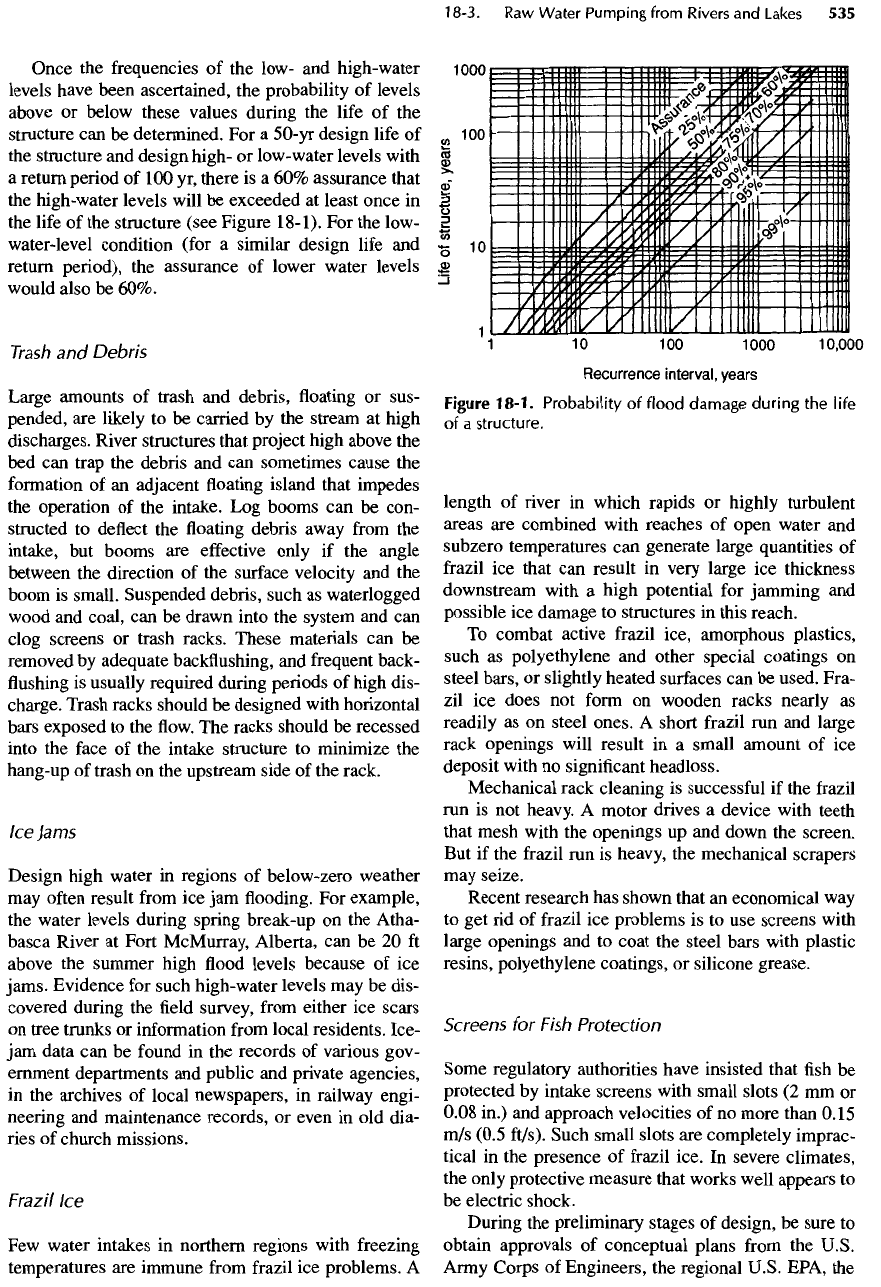
Once
the
frequencies
of the
low-
and
high-water
levels have been ascertained,
the
probability
of
levels
above
or
below these values during
the
life
of the
structure
can be
determined.
For a
50-yr
design
life
of
the
structure
and
design high-
or
low-water levels with
a
return period
of 100 yr,
there
is a 60%
assurance that
the
high-
water
levels will
be
exceeded
at
least once
in
the
life
of the
structure (see Figure
18-1).
For the
low-
water-level condition (for
a
similar design
life
and
return period),
the
assurance
of
lower water
levels
would
also
be
60%.
Trash
and
Debris
Large amounts
of
trash
and
debris,
floating or
sus-
pended,
are
likely
to be
carried
by the
stream
at
high
discharges. River structures that project high above
the
bed can
trap
the
debris
and can
sometimes cause
the
formation
of an
adjacent
floating
island that
impedes
the
operation
of the
intake.
Log
booms
can be
con-
structed
to
deflect
the floating
debris away
from the
intake,
but
booms
are
effective
only
if the
angle
between
the
direction
of the
surface
velocity
and the
boom
is
small. Suspended debris, such
as
waterlogged
wood
and
coal,
can be
drawn
into
the
system
and can
clog screens
or
trash racks. These materials
can be
removed
by
adequate
backflushing,
and
frequent back-
flushing
is
usually required during periods
of
high dis-
charge. Trash racks should
be
designed with horizontal
bars exposed
to the flow. The
racks should
be
recessed
into
the
face
of the
intake structure
to
minimize
the
hang-up
of
trash
on the
upstream side
of the
rack.
Ice
Jams
Design
high water
in
regions
of
below-zero weather
may
often
result
from
ice jam flooding. For
example,
the
water levels during spring break-up
on the
Atha-
basca River
at
Fort
McMurray,
Alberta,
can be 20 ft
above
the
summer high
flood
levels because
of ice
jams. Evidence
for
such
high-
water
levels
may be
dis-
covered during
the field
survey,
from
either
ice
scars
on
tree trunks
or
information
from
local
residents.
Ice-
jam
data
can be
found
in the
records
of
various gov-
ernment
departments
and
public
and
private agencies,
in
the
archives
of
local newspapers,
in
railway engi-
neering
and
maintenance records,
or
even
in old
dia-
ries
of
church missions.
Frazil
Ice
Few
water intakes
in
northern regions with freezing
temperatures
are
immune
from
frazil
ice
problems.
A
Figure
18-1.
Probability
of
flood
damage
during
the
life
of
a
structure.
length
of river in
which rapids
or
highly turbulent
areas
are
combined with reaches
of
open water
and
subzero temperatures
can
generate large quantities
of
frazil
ice
that
can
result
in
very large
ice
thickness
downstream with
a
high potential
for
jamming
and
possible
ice
damage
to
structures
in
this reach.
To
combat active
frazil
ice, amorphous plastics,
such
as
polyethylene
and
other special coatings
on
steel bars,
or
slightly heated surfaces
can be
used. Fra-
zil
ice
does
not
form
on
wooden racks nearly
as
readily
as on
steel ones.
A
short
frazil
run and
large
rack openings will result
in a
small amount
of ice
deposit with
no
significant headloss.
Mechanical rack cleaning
is
successful
if the
frazil
run
is not
heavy.
A
motor drives
a
device with teeth
that
mesh with
the
openings
up and
down
the
screen.
But
if the
frazil
run is
heavy,
the
mechanical scrapers
may
seize.
Recent research
has
shown that
an
economical
way
to
get rid of
frazil
ice
problems
is to use
screens
with
large openings
and to
coat
the
steel bars
with
plastic
resins, polyethylene
coatings,
or
silicone
grease.
Screens
for
Fish
Protection
Some regulatory authorities have insisted that
fish be
protected
by
intake screens with small slots
(2 mm or
0.08 in.)
and
approach velocities
of no
more than
0.15
m/s
(0.5
ft/s).
Such small slots
are
completely imprac-
tical
in the
presence
of
frazil
ice.
In
severe climates,
the
only protective measure that works well appears
to
be
electric
shock.
During
the
preliminary stages
of
design,
be
sure
to
obtain approvals
of
conceptual plans
from
the
U.S.
Army
Corps
of
Engineers,
the
regional U.S. EPA,
the
